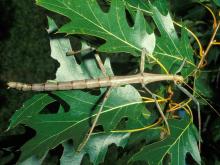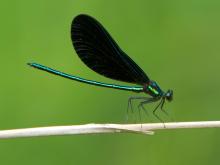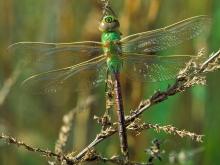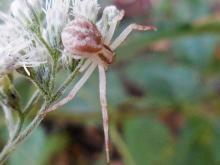Land Invertebrates
Media

Species Types
Scientific Name
Megaphasma denticrus
Description
The giant walkingstick is the largest insect in North America, with females up to 7 inches long. The middle and hind legs have spines. Males have a single, large spine on each hind leg.
Media

Species Types
Scientific Name
Diapheromera femorata
Description
The northern walkingstick is Missouri's most common species of walkingstick. It is perfectly camouflaged for a life in trees and shrubs. They not only look like twigs but also sway their bodies to mimic the motion of branches in a breeze.
Media

Species Types
Scientific Name
Zelus luridus
Description
The pale green assassin bug, Zelus luridus, is one of nearly 200 species of assassin bugs in North America. Like other assassin bugs, it is a predator that captures and eats other insects.
Media

Species Types
Scientific Name
Calopteryx maculata
Description
The ebony jewelwing is a beautiful iridescent green or turquoise damselfly with large black wings. It flutters around streams in wooded areas.
Media

Species Types
Scientific Name
Anax junius
Description
The common green darner is abundant and well-known for its bright green, blue, and purple colors. A large dragonfly up to 3 inches long, it is a migratory species that travels south in autumn.
Media

Species Types
Scientific Name
Erythemis simplicicollis
Description
The eastern pondhawk is a common and well-known large dragonfly of ponds and other standing water. Females are green with dark-banded abdomen. Mature males are blue with green face and thorax.
Media

Species Types
Scientific Name
Mecaphesa asperata
Description
The northern crab spider has many spiny hairs covering the top surfaces of the carapace, abdomen, and legs, and it has usually has greenish-yellow or yellow-brown markings.
Media

Species Types
Scientific Name
Misumessus oblongus (formerly Misumenops oblonga)
Description
The green crab spider has spines, and the entire body and legs are pale green to silvery white. Like other crab spiders, its legs extend outward from the sides, and it can walk in any direction.
Media

Species Types
Scientific Name
About 2,000 species in North America north of Mexico
Description
Plant bugs, or mirids, are a huge family of true bugs. They are often overlooked — except by gardeners and farmers. Most mirids eat plants, and some are agricultural pests. As a group, they’re an important food source for birds and other insectivores.
Media

Species Types
Scientific Name
Schistocerca spp.
Description
About six species of bird grasshoppers occur in Missouri. Most are attractively marked, large insects that gracefully fly from danger, almost like birds.
See Also



Media

Species Types
Scientific Name
Cisseps fulvicollis
Description
The yellow-collared scape moth is more often “orange-collared.” And whether you think it looks more like a firefly or a wasp, it’s still a moth!
Media

Species Types
Scientific Name
Nearly 150 species in North America north of Mexico
Description
Slim, delicate plume moths are instantly recognizable by their T-shaped silhouette, long legs, and muted shades of tan and brown. It can be hard to separate the various species.
Media

Species Types
Scientific Name
Pyrrharctia isabella
Description
Not many people know the adult Isabella tiger moth when they see one, but we’re all acquainted with its caterpillar, the woolly worm, or woolly bear.
About Land Invertebrates in Missouri
Invertebrates are animals without backbones, including earthworms, slugs, snails, and arthropods. Arthropods—invertebrates with “jointed legs” — are a group of invertebrates that includes crayfish, shrimp, millipedes, centipedes, mites, spiders, and insects. There may be as many as 10 million species of insects alive on earth today, and they probably constitute more than 90 percent all animal species.





















